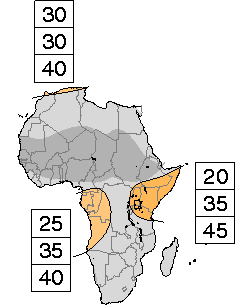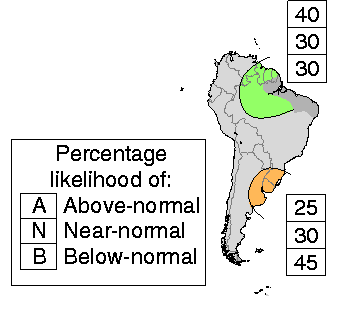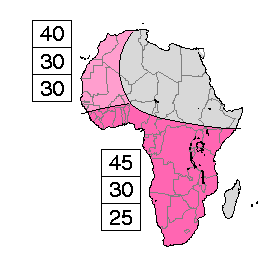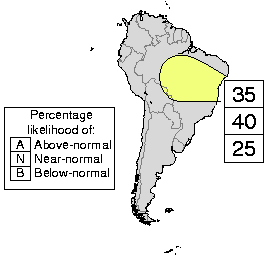IRI NET ASSESSMENT FORECAST
October to December 1998
To be updated mid October 1998
 
DISCUSSION
The IRI Experimental Forecast Division has prepared
a Climate Outlook for October through December 1998. An update will be
the October to December 1998 season and a forecast for January to March
1999 will be issued in mid October. The Precipitation and Temperature
Probabilities presented in this Outlook are based on the forecast for continued
evolution towards cooler than average sea surface temperatures (SSTs) in
the central equatorial Pacific Ocean including the west coast of South
America. The tropical Atlantic and Indian Oceans are currently warmer than
average, but the Indian Ocean and South Atlantic are expected to cool also.
The maps presented here are regional enlargements of the Net Assessment
Forecasts which appeared in the previous Digest.
PRECIPITATION OUTLOOK The Outlook for October to December 1998 can
also be found at http://iri.columbia.edu/climate/forecast/net_asmt. Maps are given
showing expected precipitation probabilities in tercile classes. The maps
indicate probabilities that seasonal precipitation will fall into the wettest
third of the years (top number), the middle third of years (middle number)
or the driest third of the years (bottom). Areas in darker gray experience
a pronounced dry season during the forecast period, typically receiving
less than 15% of their annual precipitation total during this three-month
period. Boundaries between sub regions should be considered transition
zones, and their location considered to be only qualitatively correct.
METHODS The following procedures and information were used to prepare
this Climate Outlook: 1) Coupled ocean atmosphere model predictions of
tropical Pacific SST Particularly heavy weighting has been given to the
NOAA /NCEP, Climate Modeling Branch coupled model which suggests continued
development of weak to moderate La Niña conditions, with the persistence
of strong positive sea surface temperature anomalies near Indonesia, 2)
Atmospheric global circulation model (GCM) predictions response to the
present and predicted SST patterns, 3) Statistical analyses, 4) Appropriate
Regional Climate Outlook Forum consensus guidance. The procedures, models,
and data used to derive this Climate Outlook may be somewhat different
from those used by National Meteorological Services in particular regions
may differ from the official forecasts issued in those areas. This Outlook
has been prepared in the time available, using all information that was
reasonably accessible. Inclusion of other climate information and guidance
requires further arrangements. The IRI is engaged in establishing collaborative
arrangements with the goal of improving its capability to provide the best
and most complete global climate guidance.
The Climate Outlook for October - December 1998 is dependent on the
quality of the SST predictions. For the tropical Pacific, these predictions
can be expected to provide useful information, but there is considerable
spread in coupled model predictions concerning the evolution of SSTs. This
spread in predictions is a primary source of uncertainty in the Outlook
provided here, which assumes that tropical Pacific SST's will continue
to decline at a modest rate, resulting in moderate La Niña conditions
by the end of the year. Also, it is known that Indian and Atlantic Ocean
SSTs may play some role in modulating precipitation changes over parts
of Africa. Thus, the uncertainties in Indian and Atlantic Ocean SST values
during the forecast period may lead to additional uncertainty over some
parts of the world.
It is stressed that the current status of seasonal-to-interannual climate
forecasting allows prediction of spatial and temporal averages, and does
not fully account for all factors that influence regional and national
climate variability. This Outlook is relevant only to seasonal time scales
and relatively large areas; local variations should be expected. For further
information concerning this and other guidance products, users are strongly
advised to contact their National Meteorological Services.
 
Oct-Dec 1998 Temperature Probabilities
TEMPERATURE OUTLOOK The Outlook for October - December 1998 can also
be found at http://iri.columbia.edu/climate/forecast/net_asmt. An update will
be the October to December 1998 season and a forecast for January to March
1999 will be issued in mid October. The temperature map show expected
probabilities that the seasonal temperatures will fall into the warmest
third of the years (top number), the middle third of the years, or the
coldest third of the years (bottom number). Boundaries between sub-regions
should be considered transition zones, and their location considered to
be only qualitatively correct. The maps presented here are regional enlargements
of the Net Assessment Forecasts which appeared in the previous Digest.
| Sources of information
include ACMAD, Caribbean Meteorological Institute, CPTEC, CPC/NOAA, Department
of Natural Resources (Queensland, Australia), ECMWF, Indian Meteorological Department,
South African Weather Service, University of Reading, University of Oklahoma |
|